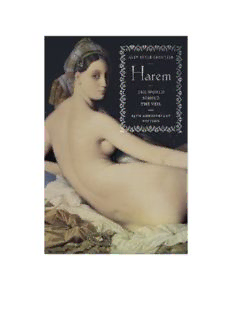
Harem: The World Behind the Veil PDF
Preview Harem: The World Behind the Veil
“This is a serious history, yet an immensely readable one—informative, gossipy, and grand fun.” —New York Times Book Review “This beautiful book … stimulates the mind as well as the eye” —Chicago Sun-Times “An alluring invitation into the labyrinthine corridors of the Turkish harem.” —San Francisco Chronicle About Harem: The World Behind the Veil, 25th Anniversary Edition In this fascinating illustrated history—a worldwide best seller—Alev Lytle Croutier explores life in the world’s harems, from the Middle Ages to the early twentieth century, focusing on the fabled Seraglio of Topkapi Palace as a paradigm for them all. We enter the slave markets and the lavish boudoirs of the sultanas; we witness the daily routines of the odalisques, and of the eunuchs who guarded the harem. Drawing on her own family history, Croutier also reveals the marital customs, child-rearing practices, and pastimes of “middle-class” harems, the women’s quarters of ordinary—albeit often polygamous—households. Finally, she shows us how the Eastern idea of the harem invaded the European imagination—in the form of decoration, costume, and art—and how Western ideas, in turn, finally eroded a system that had seemed eternal. This revised and updated 25th Anniversary Edition of Harem includes a new introduction by the author, revisiting her subject in light of recent events in Turkey, and the world. About the Author Alev Lytle Croutier is the author of Taking the Waters (Abbeville) and three critically acclaimed novels, The Palace of Tears, Seven Houses, and Leyla: The Black Tulip. Born in Turkey, Croutier studied at Oberlin College and founded the publishing company Mercury House. Harem is also available in paperback. To view our complete selection of e-books, visit www.abbeville.com/digital. Detail of Harem Scene at the Court of Shah Jahan, by an unknown artist. To all who danced the seven veils, my mother, grandmothers, and aunts. Contents COVER ABOUT HAREM: THE WORLD BEHIND THE VEIL FRONTISPIECE TITLE PAGE DEDICATION HAREM REVISITED PREFACE The Grand Harem INTRODUCTION meaning, origins, polygamy, slave markets, harem of the Seraglio, acquisition of slaves, training of odalisques, sultanas, eunuchs, dynasty, the Golden Cage, death, the world of extremes DAILY LIFE IN THE SULTAN’S HAREM harem walls, gardens, games, pools, riddles and stories, poetry, prayer, secrets of flowers and birds, opium, song and dance, shadow puppets, shopping, excursions, visits and outings, festivals and special days, disenchantment COSTUME AND FINERY passing of the veil THE BATHS FOOD SULTANAS marriage of sultans, harem women and politics, valide procession, princess sultanas, remarriage of sultanas, accouchement and birth, death of sultanas, Roxalena (Hürrem Sultana), Kösem Sultana, Aimée DeBucq de Rivery (Nakshedil Sultana) EUNUCHS Süleyman Ağa, origins, types of eunuchs, eunuch trade, procedures, Chinese eunuchs, effects of castration, sexual desire and consummation, marriage of eunuchs, regeneration of genitals, the chief black eunuch (kizlar ağasi) Harem Life in the City ORDINARY HAREMS the go-betweens, romance, gifts, henna night, weddings, husband-wife relationships, polygamy, relationships among wives, superstition and charms, upkeep, odalisques, jewelry, living quarters, bundle women, death West Meets East ORIENTAL DREAM One Thousand and One Nights, wind from the East, Lady Mary Montagu, journey to the Orient, John Frederick Lewis, the Romantics, Jean-Léon Gérôme and the camera, Amadeo Count Preziosi, Empress Eugénie, Pierre Loti, emancipation of the East, the last picture SURVIVALS twentieth-century Orientalist threads, movies and television, harems today CHRONOLOGY BIBLIOGRAPHY ACKNOWLEDGMENTS INDEX PICTURE CREDITS COPYRIGHT Harem Revisited It’s odd to realize that a quarter-century has passed since the publication of Harem: The World Behind the Veil, and it’s still alive. I was delighted when Robert Abrams, my former publisher, had the idea of reissuing the book on its twenty-fifth anniversary. Harem was the first book to explore this secret world of women from a feminine perspective. My intentions were primarily personal and cultural: to reflect on my family history and demystify the concept of the harem, which the Western imagination had turned into a dark, exotic, and erotic dream. I wanted to show the complex realities of this utterly private realm, which were far removed from the titillating depictions of odalisques by Western painters and writers. At the same time, I also considered what these fantasies said about the West itself—why it wanted to see its own women in a romantic Oriental guise. Harem originally took me ten years to research and write, tracking down volumes in the dimly lit libraries and dusty archives of strange cities, digging into family stories, or having tea with ancient ladies who had lost their logic but still could make evocative connections in the interstices of their memory, memory that was as fragmented as the idea of the harem itself. No definitive sources existed on the subject. No Google to search. No Wikipedia to consult. It was simply a low-tech, labor-intensive process of assembling tesserae that had, like most Turkish antiquities, been scattered into faraway places. I’m very pleased that other writers and scholars have since built on my research and produced remarkable new insights into harem life. Their work has claimed an important space in women’s studies and led to more understanding, more dialogue. Since the first publication of Harem, the world has changed, and we have, in particular, seen many intense dramas concentrated on the Middle East: the Gulf War, 9/11, the wars in Afghanistan and Iraq, the Arab Spring, the relentless conflict between Israel and Palestine, and a tsunami of Islamization. Partly as a
Description: